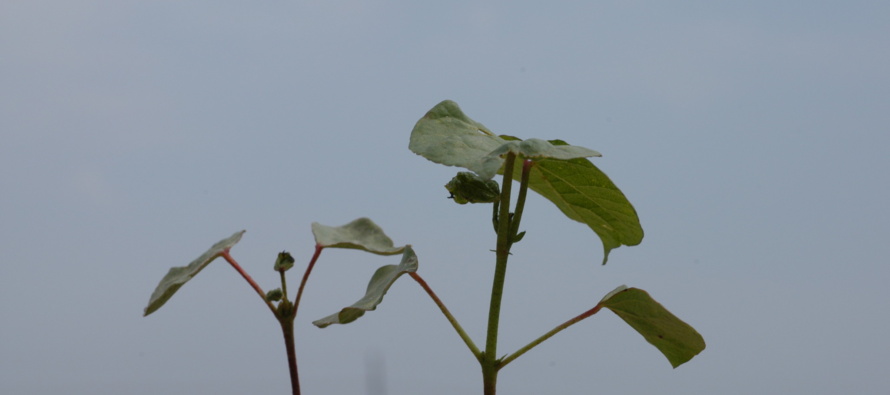Thrips Pressure Starting off Heavy in MS Cotton

Related Articles
- Fertilizing Cotton with Poultry Litter 5
- Flag The Technology 0
- Mississippi Cotton Insect Situation of 2010: A Look Back 3
Latest Tweets
Calls about thrips treatments in seedling cotton have been picking up substantially this week. As ryegrass and other ditchbank hosts begin to dry down, thrips numbers will likely increase in the next couple weeks. The 100% chance of rain today (5/20) now looks like most areas will get none, again, further contributing to the problem. Rain has always been decent at beating numbers down on seedling cotton. Seed treatment performance appears to be erratic so far. Most reports of imidacloprid treated seed that was over treated with an acephate seed treatment are extremely positive, Aeris appears strong as well at this time; however, imidacloprid alone has provided erratic thrips control. There is very little thiamethoxam treated cotton seed anymore in Mississippi, but if you have it, you need to make and automatic foliar application at the 1 leaf stage.
Some areas are experiencing extremely high numbers of adult thrips and taking damage to true leaves. I have had several reports of high numbers of adults as quickly as 2 days after treatment. With the number of adult thrips we have on the move right now, I do not think this unexpected or a sign that the treatment did not work. Watch new growth very closely. If new growth is looking good, the treatment worked. Also, watch for immatures. When immatures show up, the treatment is breaking. We found quite a few immatures in cotyledon stage cotton yesterday.
Every year we get a lot of questions about potential cotton injury or problems associated with mixing thrips insecticides with POST herbicides. This will no doubt be controversial, but we are going to lay it out like we would if you called.
To start, we are primarily talking about three herbicides that are used most commonly over the top of cotton during the thrips stage. These are acetochlor (Warrant), glufosinate (Liberty 280), and metolachlor-based products (Dual Magnum, Sequence, etc.) applied alone or sometimes in mixtures with glyphosate. Also, you have to take into account if the Liberty 280 and combinations are going out on Glytol/LibertyLink, XtendFlex, or WideStrike varieties.
We have evaluated numerous insecticide/herbicide combinations over the years across the whole Midsouth region for compatibility and crop safety. While we cannot guarantee every adjuvant/herbicide/insecticide combination, we have certainly evaluated the most likely combinations.
Take Home: Metolachlor-based products, Liberty 280 (on WideStrike cotton), and Warrant can and will often burn (injure) cotton without any insecticide in the tank. Burn is nearly always cosmetic and poses no risk to yield. The addition of an insecticide can sometimes enhance the burn but rarely above the herbicides own injury potential. There are four insecticides we recommend for thrips control; Acephate, Radiant, Bidrin, and Dimethoate. Acephate and Radiant are the safest followed by Bidrin. In fact, Dimethoate is the only one in the group that consistently causes any additional burn when mixed with herbicides, and this is rarely severe.
The reason herbicide/insecticide mixtures are controversial is everyone has a story about a time when they burned cotton when an insecticide was in the tank. Chances are you would have burned the cotton anyway from the herbicide alone.
One true exception is the addition of a metolachlor-based product or Warrant with Liberty 280 on WideStrike and XtendFlex cotton. This is the hottest combination we have evaluated and IT IS worse when mixed with Dimethoate or Bidrin. However, we are perfectly fine with mixing the insecticide alone with either Liberty 280 or metolachlor/Warrant, but not in combination, particularly on Widestrike cotton. We observed substantial visual injury on XtendFlex cotton from applications of Liberty plus Dual Magnum last year. However, two weeks after application injury was minimized and no yield reductions were observed. If you are making applications of Liberty plus Dual Magnum with or without an insecticide, be prepared to see injury on XtendFlex cotton. Again, in our trials last year, injury was transient and did not impact yield.
No one likes walking injured fields trying to determine the cause, so the simple answer you will hear most often is do not mix the insecticide with the herbicide. Fact is, I would not hesitate to mix one of these thrips insecticides from an injury standpoint and save the money on application fees, but for specific questions please give one of us a call.




Thrips pressure has been coupled with some Reflex “splash” damage and sand blasting.